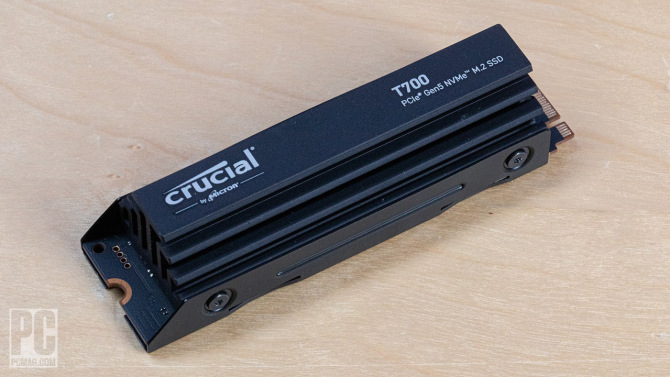[ad_1]
Before PCIe Gen 5 SSDs hit the market, there were questions about how hot they might get during extended operation. Since they theoretically offer double the performance of current Gen 4 drives, it was thought they could generate enough heat to require active cooling instead of the thin, passive heatsinks we’ve used for years. Now that Gen 5 SSDs are landing in the reviewers’ hands, we’re seeing troubling signs of thermal throttling, bolstering previous concerns over their cooling requirements. Corsair’s newest Gen 5 drive will apparently just turn off if it gets too hot, and Crucial’s newest drive has also exhibited shockingly slow write speeds when thermal throttling.
Both drives were the subject of a recent review by the German site Computerbase.de since they use the Phison E26 NAND controller. The review discovered surprising behavior from both drives when hitting their thermal limit. For the Corsair drive, the site says it crashed the test bench when it hit 87C, which wasn’t too far from its 60C idle temp. The Corsair website lists the “storage temperature” as +85C, so it sounds like when it overheats, the SSD turns off to protect the controller and data. This is a big problem if this is your boot drive, as it could lead to data corruption after an unexpected shutdown.

The drive’s write performance drops so far off when thermal throttling its comparable to a hard drive.
Credit: Computerbase.de
The review site says Corsair initially shipped MP700 drives to reviewers that used a heatsink and fan combo to cool the SSD. However, when reviewers told Corsair they didn’t like it because it was “permanently audible,” Corsair scrapped it altogether. Instead, it’ll sell “naked” drives to customers while advising them it must have adequate cooling, either from the motherboard’s built-in SSD heatsinks or with some form of third-party cooling. Corsair likens the situation to buying a CPU, which needs an aftermarket product to keep it cool.
When it comes to Crucial’s T700 SSD, the situation is improved because it won’t shut down when it hits its thermal limit. However, the review shows the drive drastically reduces performance when throttling, putting it on par with a spinning hard drive for write speeds. In CrystalDiskMark, the Crucial T700 hit 102MB/s write speeds when throttling at 86C, but it didn’t crash the system. The reviewers stated the drive is just as unusable at high temps as the Corsair drive but with the benefit of the system remaining stable. Crucial will notably sell this drive with a heatsink and without, and its website notes that the “naked” version requires additional cooling “to achieve optimal performance.”

The Crucial T700 can be purchased with or without a heatsink, so plan accordingly.
Credit: Molly Flores
It’s noteworthy that the speculation that these drives can’t be run without a large heatsink turned out to be correct. As TechPowerUp notes, the issue will concern notebook vendors hoping to use Gen 5 SSDs. However, the good news for desktop PC users is most motherboards these days do include large, full-coverage heatsinks for the primary M.2 slot, which should provide adequate cooling. Our sister site PCMag reviewed the Crucial T700 and didn’t report any thermal throttling issues; as always, your mileage may vary according to your case’s airflow. Regardless, if you plan on getting a Gen 5 SSD, heat dissipation is something you’ll need to consider.
[ad_2]
Source link
















